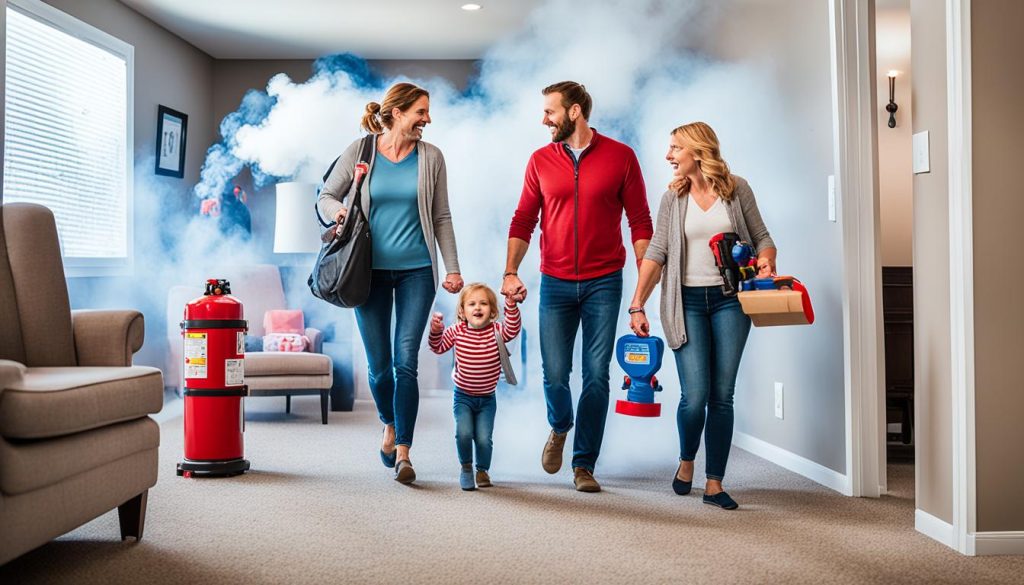Did you know over 350,000 home fires happen in the US every year? Having a clear emergency plan for your home is vital. Fires can move quickly, leaving little time to get out. It’s key to be ready and have a plan to keep your family safe.
Key Takeaways:
- Create a written emergency evacuation plan for your home.
- Include at least two escape routes from every room.
- Practice evacuating your home in under 2 minutes.
- Designate a safe meeting place outside.
- Install smoke alarms on every level of your home.
Home Fire Escape Plan
A home fire escape plan is vital for your family’s safety in case of a fire. It’s important to be ready and know how to get out. This helps lower panic and makes leaving the house easier.
Remember these tips when making a fire escape plan at home:
- Know two ways out of every room. This means you should have more than one route to safety. Think about using doors, windows, balconies, or finding a way through another room.
- Practice going low and crawling. In a fire, the air near the floor is usually better to breathe. Everyone should know to stay close to the ground when escaping.
- Pick a meet-up spot outside. Decide on a place where everyone will go once they’re out. This could be a neighbor’s place, a certain tree, or another secure place nearby.
- Get escape ladders for upper floors. For rooms that are higher up, having a ladder can be a lifesaver. It’s useful if the usual paths are blocked or too dangerous to use.
- Teach kids about fire safety. It’s crucial for kids to understand what to do if there’s a fire. Make sure they know never to re-enter a burning building and to stick to the plan.
Making a fire escape plan isn’t enough by itself. It’s key to regularly go over the plan with your family. This ensures everyone knows what to do. You should also do fire drills at different times, so everyone is ready for an emergency.
By following these steps and staying prepared, you can help keep your family safe in a fire. Everyone should know what to do and act fast if danger strikes.
| Key Points | Details |
|---|---|
| Know two ways out | Have multiple exit routes for each room |
| Get low and crawl | Minimize smoke inhalation by crawling |
| Designate a safe meeting place | Choose a location outside the home |
| Install escape ladders | For upper-level rooms |
| Teach children about fire safety | Never go back inside a burning building |
Home Fire Drills
Performing regular home fire drills is key for safety. It ensures everyone at home knows how to escape during a fire. Several steps are vital to make these drills effective.
- Run through your escape plan at various times: Practice at different hours improves reaction speed. It familiarizes your family with multiple escape routes.
- Practice different ways out: Ensure you know more than one way to leave your house. Tip: Test different routes during the drills.
- Choose a safe meeting spot outside: Everyone should know where to meet up after leaving the house. This gathering point is crucial for headcounts.
- Test your smoke alarms regularly: Early fire detection starts with working smoke alarms. Check them every month and replace batteries as needed. Use their sound in your drills to help kids understand its importance.
Following these steps greatly prepares your family for fire emergencies. Your home fire drills will be more effective and safer.
Virtual Reality Fire Safety Training
Virtual reality fire safety experiences help us get better at escaping from fires. They do this in a way that’s both unique and effective. Set in a safe space, these experiences let you face fires head-on.
Meta, FEMA’s Ready Campaign, and the Ad Council have teamed up to make Escape Plan VR. In this virtual world, you’ll tackle fire scenarios in an apartment. It will test how fast you can make decisions to stay safe.
This type of training puts you in the heart of a fire emergency, teaching you what to do quickly. It covers skills like picking the best escape route and staying under smoke. You also learn to find exits safely.
VR fire safety training sharpens real-life escape skills without any danger. It’s perfect for those who find regular drills tough. And for those who don’t get many chances to practice in real buildings.
Using VR alongside regular fire drills deepens our grasp of fire safety. It also gives a boost to our self-assurance when facing danger.
| Benefits of Virtual Reality Fire Safety Training | Traditional Fire Safety Training |
|---|---|
| Realistic simulation of fire emergencies | Limited exposure to realistic scenarios |
| Immersive experience for enhanced learning | Passive learning through lectures and demonstrations |
| Opportunity to practice decision-making skills | Minimal opportunities for active participation |
| Safe environment for trial and error learning | Potential risks associated with live drills |
VR fire safety training is a game-changer in how we get ready for emergencies. It equips us with the right skills and mindset to keep safe. And, importantly, to protect those we care about.
Creating a Home Emergency Plan
It’s not just fires you should plan for. Include other disasters in your home emergency plan. Be sure to meet the specific needs of your family, like if someone has a disability or medical issue. This makes sure everyone stays safe.
Make a kit with supplies for at least 72 hours. Include food, water, medicine, and first aid. Also, put flashlights, batteries, and a radio in it.
Know the safest areas in your house for different kinds of emergencies. For a tornado, pick a room without windows on the bottom floor. Teach everyone where these spots are and how to get to them fast.
Set up a way to get in touch with each other and your emergency contacts. Have someone outside the area everyone can call or text. Give everyone their number. Show them how to send texts, which work better when cell service is bad.
Keep your plan up to date by checking it often. Make sure your kit is ready and try out your plan. Make any needed changes based on what you learn or if your family’s situation changes.
| Emergency Supplies Checklist |
|---|
| Non-perishable food |
| Water |
| Medications |
| First aid supplies |
| Flashlights |
| Batteries |
| Battery-powered radio |
Think about everyone in your family when making an emergency plan. By getting ready now, you can make a big difference if something bad happens.
Staying Connected During Emergencies
During crises, keeping in touch with your loved ones is vital. Make sure you’ve got a family communication plan ready. This plan should explain how to get emergency alerts and stay in touch. Also, save important phone numbers and choose a out-of-area contact for everyone to reach out to.
Cell phones are crucial for staying connected in emergencies. Always keep your mobile phone batteries charged. This ensures they can be used when needed. Even if you don’t have service, you can call 911 for help.
During emergencies, sending texts is better than making calls. Texts are more likely to get through, especially when networks are busy. So, use texts to share important news.
If the power goes out, traditional landline services will still work. VOIP services might also work if they have a back-up battery for up to eight hours.
According to state law, cable companies should give you a credit if service is down for 24 hours or more. They should also aim to fix service issues quickly after a storm.
Remember, if the power’s out, cable won’t work until electricity is back on.
Use social media like Facebook’s safety check to mark yourself safe. Websites like the American Red Cross Safe and Well can help you get or share important updates.
Always be ready with a communication plan and good ways to connect with others. This is key to managing challenges and responding well during emergencies.
Pet Safety in Emergency Evacuations
It’s key to plan for emergencies with our pets in mind. The ASPCA states that each year, about 6.5 million pets go to shelters in the U.S. very few of these animals get back to their families, showing how important it is to be ready and keep pets identifiable.
A study in 2019 by the American Pet Products Association showed that 67% of American homes had a pet. This makes pet safety in emergencies very important.
The FEMA advises to add pet-friendly places on your evacuation route. This step helps make sure you find safe places for your pets during crises.
Preparing a disaster kit for your pets is crucial. Include their food, water, meds, and leashes. Think about what they need to be safe and comfortable.
During emergencies, local officials and animal groups can offer valuable help and info. They can guide you to safe evacuation paths and temporary shelters for your pets.
We must treat our pets as family. This means we must protect and care for them when trouble comes.
Statistics on Pet Safety in Emergency Evacuations
| Statistic | Numbers |
|---|---|
| Companion animals entering U.S. animal shelters annually | Around 6.5 million |
| Percentage of reunited pets with owners during emergencies | Small |
| Percentage of U.S. households owning a pet in 2019 | 67% |
Don’t forget your pet when preparing for emergencies. Include them in all your plans. With pet-friendly spots and a good disaster kit, you’ll keep your pets safe during evacuations.
Conclusion
Emergency preparedness is essential for keeping your family safe. It’s vital to have a clear evacuation plan and practice it often. This reduces stress during a fire or disaster. Make sure your plan fits everyone’s needs, like those with special health needs.
Don’t forget about a kit with supplies for three days. It is very helpful for your safety. Know where to go in different emergencies.
Your family must stay in touch during hard times too. Create a plan for how to get news and who to contact if you’re separated. Online tools and safe websites can also be great to let family know you are okay.
Also, check your insurance to see that it covers emergencies. Doing this helps make your home safer. Being ready and knowing what to do is crucial for protecting your family.


